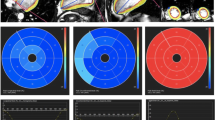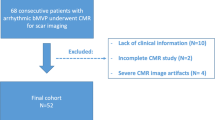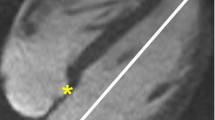Abstract
Objectives
T1 mapping (T1-map) and cardiac magnetic resonance feature tracking (CMR-FT) techniques have been introduced for the early detection of interstitial myocardial fibrosis and deformation abnormalities. We sought to demonstrate that T1-map and CMR-FT may identify the presence of subclinical myocardial structural changes in patients with mitral valve prolapse (MVP).
Methods
Consecutive MVP patients with moderate-to-severe mitral regurgitation and comparative matched healthy subjects were prospectively enrolled and underwent CMR-FT analysis to calculate 2D global and segmental circumferential (CS) and radial strain (RS) and T1-map to determine global and segmental native T1 (nT1) values.
Results
Seventy-three MVP patients (mean age, 57 ± 13 years old; male, 76%; regurgitant volume, 57 ± 21 mL) and 42 matched control subjects (mean age, 56 ± 18 years; male, 74%) were included. MVP patients showed a lower global CS (− 16.3 ± 3.4% vs. − 17.8 ± 1.9%, p = 0.020) and longer global nT1 (1124.9 ± 97.7 ms vs. 1007.4 ± 26.1 ms, p < 0.001) as compared to controls. Moreover, MVP patients showed lower RS and CS in basal (21.6 ± 12.3% vs. 27.6 ± 8.9%, p = 0.008, and − 13.0 ± 6.7% vs. − 14.9 ± 4.1%, p = 0.013) and mid-inferolateral (20.6 ± 10.7% vs. 28.4 ± 8.7%, p < 0.001, and − 12.8 ± 6.3% vs. − 16.5 ± 4.0%, p < 0.001) walls as compared to other myocardial segments. Similarly, MVP patients showed longer nT1 values in basal (1080 ± 68 ms vs. 1043 ± 43 ms, p < 0.001) and mid-inferolateral (1080 ± 77 ms vs. 1034 ± 37 ms, p < 0.001) walls as compared to other myocardial segments. Of note, nT1 values were significantly correlated with CS (r, 0.36; p < 0.001) and RS (r, 0.37; p < 0.001) but not with regurgitant volume.
Conclusions
T1-map and CMR-FT identify subclinical left ventricle tissue changes in patients with MVP. Further studies are required to correlate these subclinical tissue changes with the outcome.
Key Points
• T1 mapping (T1-map) and cardiac magnetic resonance feature tracking (CMR-FT) techniques have been introduced for the early detection of interstitial myocardial fibrosis and deformation abnormalities.
• In MVP patients, we demonstrated a longer global nT1 with associated reduced global circumferential (CS) and radial strain (RS) as compared to control subjects.
• Among MVP patients, the mid-basal left ventricle inferolateral wall showed longer nT1 with reduced CS and RS as compared to other myocardial segments. Further studies are required to correlate these subclinical tissue changes with the outcome.





Similar content being viewed by others
Abbreviations
- CMR:
-
Cardiac magnetic resonance
- CS:
-
Circumferential strain
- FT:
-
Feature tracking
- LS:
-
Longitudinal strain
- LV:
-
Left ventricle
- MAD:
-
Mitral annular disjunction
- MR:
-
Mitral regurgitation
- MVP:
-
Mitral valve prolapse
- nT1:
-
Native T1 value
- RS:
-
Radial strain
- SCD:
-
Sudden cardiac death
- T1-map:
-
T1 mapping
References
Delling FN, Vasan RS (2014) Epidemiology and pathophysiology of mitral valve prolapse: new insights into disease progression, genetics, and molecular basis. Circulation 129:2158–2170
Levine RA, Hagege AA, Judge DP et al (2015) Mitral valve disease--morphology and mechanisms. Nat Rev Cardiol 12:689–710
Nishimura RA, McGoon MD, Shub C, Miller FA Jr, Ilstrup DM, Tajik AJ (1985) Echocardiographically documented mitral-valve prolapse. Long-term follow-up of 237 patients. N Engl J Med 313:1305–1309
Narayanan K, Uy-Evanado A, Teodorescu C et al (2016) Mitral valve prolapse and sudden cardiac arrest in the community. Heart Rhythm 13:498–503
Lancellotti P, Garbi M (2016) Malignant mitral valve prolapse: substrates to ventricular remodeling and arrhythmias. Circ Cardiovasc Imaging 9:e005248
Hourdain J, Clavel MA, Deharo JC et al (2018) Common phenotype in patients with mitral valve prolapse who experienced sudden cardiac death. Circulation 138:1067–1069
Hutchins GM, Moore GW, Skoog DK (1986) The association of floppy mitral valve with disjunction of the mitral annulus fibrosus. N Engl J Med 314:535–540
Basso C, Perazzolo Marra M, Rizzo S et al (2015) Arrhythmic mitral valve prolapse and sudden cardiac death. Circulation 132:556–566
Kitkungvan D, Nabi F, Kim RJ et al (2018) Myocardial fibrosis in patients with primary mitral regurgitation with and without prolapse. J Am Coll Cardiol 72:823–834
Perazzolo Marra M, Basso C, De Lazzari M et al (2016) Morphofunctional abnormalities of mitral annulus and arrhythmic mitral valve prolapse. Circ Cardiovasc Imaging 9:e005030
Salerno M, Kramer CM (2009) Advances in cardiovascular MRI for diagnostics: applications in coronary artery disease and cardiomyopathies. Expert Opin Med Diagn 3:673–687
Messroghli DR, Moon JC, Ferreira VM et al (2017) Clinical recommendations for cardiovascular magnetic resonance mapping of T1, T2, T2* and extracellular volume: a consensus statement by the Society for Cardiovascular Magnetic Resonance (SCMR) endorsed by the European Association for Cardiovascular Imaging (EACVI). J Cardiovasc Magn Reson 19:75
Puntmann VO, D'Cruz D, Smith Z et al (2013) Native myocardial T1 mapping by cardiovascular magnetic resonance imaging in subclinical cardiomyopathy in patients with systemic lupus erythematosus. Circ Cardiovasc Imaging 6:295–301
Schuster A, Hor KN, Kowallick JT, Beerbaum P, Kutty S (2016) Cardiovascular magnetic resonance myocardial feature tracking: concepts and clinical applications. Circ Cardiovasc Imaging 9:e004077
Zerhouni EA, Parish DM, Rogers WJ, Yang A, Shapiro EP (1988) Human heart: tagging with MR imaging--a method for noninvasive assessment of myocardial motion. Radiology 169:59–63
Lancellotti P, Tribouilloy C, Hagendorff A et al (2013) Recommendations for the echocardiographic assessment of native valvular regurgitation: an executive summary from the European Association of Cardiovascular Imaging. Eur Heart J Cardiovasc Imaging 14:611–644
Pepi M, Tamborini G, Maltagliati A et al (2006) Head-to-head comparison of two- and three-dimensional transthoracic and transesophageal echocardiography in the localization of mitral valve prolapse. J Am Coll Cardiol 48:2524–2530
Tamborini G, Muratori M, Maltagliati A et al (2010) Pre-operative transthoracic real-time three-dimensional echocardiography in patients undergoing mitral valve repair: accuracy in cases with simple vs. complex prolapse lesions. Eur J Echocardiogr 11:778–785
Carpentier A (1983) Cardiac valve surgery--the "French correction". J Thorac Cardiovasc Surg 86:323–337
Kramer CM, Barkhausen J, Flamm SD, Kim RJ, Nagel E (2013) Standardized cardiovascular magnetic resonance (CMR) protocols 2013 update. J Cardiovasc Magn Reson 15:91
Uretsky S, Argulian E, Narula J, Wolff SD (2018) Use of cardiac magnetic resonance imaging in assessing mitral regurgitation: current evidence. J Am Coll Cardiol 71:547–563
Cerqueira MD, Weissman NJ, Dilsizian V et al (2002) Standardized myocardial segmentation and nomenclature for tomographic imaging of the heart. A statement for healthcare professionals from the Cardiac Imaging Committee of the Council on Clinical Cardiology of the American Heart Association. Int J Cardiovasc Imaging 18:539–542
Gripari P, Mapelli M, Bellacosa I et al (2018) Transthoracic echocardiography in patients undergoing mitral valve repair: comparison of new transthoracic 3D techniques to 2D transoesophageal echocardiography in the localization of mitral valve prolapse. Int J Cardiovasc Imaging 34:1099–1107
Uretsky S, Gillam L, Lang R et al (2015) Discordance between echocardiography and MRI in the assessment of mitral regurgitation severity: a prospective multicenter trial. J Am Coll Cardiol 65:1078–1088
Edwards NC, Moody WE, Yuan M et al (2014) Quantification of left ventricular interstitial fibrosis in asymptomatic chronic primary degenerative mitral regurgitation. Circ Cardiovasc Imaging 7:946–953
Bui AH, Roujol S, Foppa M et al (2017) Diffuse myocardial fibrosis in patients with mitral valve prolapse and ventricular arrhythmia. Heart 103:204–209
Muscogiuri G, Suranyi P, Schoepf UJ et al (2018) Cardiac magnetic resonance T1-mapping of the myocardium: technical background and clinical relevance. J Thorac Imaging 33:71–80
Taylor AJ, Salerno M, Dharmakumar R, Jerosch-Herold M (2016) T1 Mapping: basic techniques and clinical applications. JACC Cardiovasc Imaging 9:67–81
Almutairi HM, Boubertakh R, Miquel ME, Petersen SE (2017) Myocardial deformation assessment using cardiovascular magnetic resonance-feature tracking technique. Br J Radiol 90:20170072
Peng J, Zhao X, Zhao L et al (2018) Normal values of myocardial deformation assessed by cardiovascular magnetic resonance feature tracking in a healthy Chinese population: a multicenter study. Front Physiol 9:1181
Miller MA, Dukkipati SR, Turagam M, Liao SL, Adams DH, Reddy VY (2018) Arrhythmic mitral valve prolapse: JACC review topic of the week. J Am Coll Cardiol 72:2904–2914
Nakamori S, Dohi K, Ishida M et al (2018) Native T1 mapping and extracellular volume mapping for the assessment of diffuse myocardial fibrosis in dilated cardiomyopathy. JACC Cardiovasc Imaging 11:48–59
Funding
The authors state that this work has not received any funding.
Author information
Authors and Affiliations
Corresponding author
Ethics declarations
Guarantor
The scientific guarantor of this publication is Gianluca Pontone.
Conflict of interest
Gianluca Pontone declares institutional research grant and/or honorarium as speaker from General Electric, Bracco, Medtronic, Bayer, and Heartflow. Daniele Andreini declares institutional research grant and/or honorarium as speaker from General Electric, Bracco, and Heartflow. The other authors have no disclosure.
Statistics and biometry
One of the authors (Laura Fusini) has significant statistical expertise.
Informed consent
Written informed consent was obtained from all subjects (patients) in this study.
Ethical approval
Institutional Review Board approval was obtained.
Methodology
• Prospective, observational study
• performed at one institution
Additional information
Publisher’s note
Springer Nature remains neutral with regard to jurisdictional claims in published maps and institutional affiliations.
Electronic supplementary material
Figure S1
Dot plot of radial strain (Upper Row), circumferential strain (Middle row) and native T1 values (Lower row) of the basal (left panel) and mid (right panel) inferolateral segments of the left ventricle versus other segments in MVP patients and controls. MVP: mitral valve prolapse; *:p < 0.05 MVP patients vs. control subjects (PPTX 132 kb)
Rights and permissions
About this article
Cite this article
Guglielmo, M., Fusini, L., Muscogiuri, G. et al. T1 mapping and cardiac magnetic resonance feature tracking in mitral valve prolapse. Eur Radiol 31, 1100–1109 (2021). https://doi.org/10.1007/s00330-020-07140-w
Received:
Revised:
Accepted:
Published:
Issue Date:
DOI: https://doi.org/10.1007/s00330-020-07140-w




